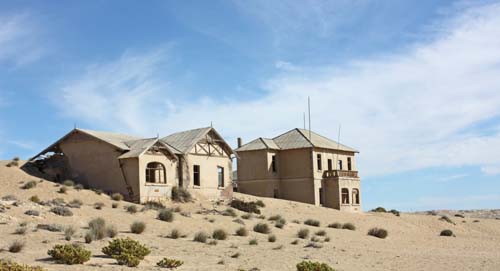Kolmanskop - A Ghost Town EarthCache
Kolmanskop - A Ghost Town
-
Difficulty:
-

-
Terrain:
-

Size:  (not chosen)
(not chosen)
Please note Use of geocaching.com services is subject to the terms and conditions
in our disclaimer.

The History Of Kolmanskop
Kolmanskop was a village that owes its life and its death a
mineral: the diamond.
In April of 1908 a worker on the railway line between Lüderitz and
Aus found a stone and showed it to his supervisor, August Stauch.
Stauch knew what this stone was. After a geologist confirmed that
he was right, he got himself the prospecting license. The diamond
rush began…
The government declared a "forbidden zone", or "Sperrgebiet" from
the Oranje River in the south, 360 km north and 100 km inland from
the coast. The Sperrgebiet was established to give the government
control over the region that promised such a wealth. Down to the
present day the Sperrgebiet exists and rigorous punishments are
inflicted on those who set foot into the area without a valid
permit!
In the 1920s, Kolmanskop was booming. There were up to 400
residents in the village. They built a hospital, a school, a
gymnasium, a casino, a concert hall, a bowling alley, a light
railway, a butchery and a bakery in the desert. Almost everything
was imported, even fresh water from Cape Town in South Africa.
Kolmanskop was considered as the richest town in Africa.
But the boom didn't last long. By 1928 larger diamond deposits had
been found further south and people began to leave. The last
residents left in 1956 and Kolmanskop has been deserted ever
since.
In 1980 Kolmanskop was opened for visitors. A ghost town is all
that remains of the richest community in Africa. The desert takes
back what belongs to the desert…

About The Diamond
A diamond is an allotrope of carbon. It’s the material with
the highest hardness and thermal conductivity which was ever found
on earth. The optical qualities of diamonds are also worth
remarking. Because of its extremely rigid lattice, it can be
contaminated by very few types of impurities. This and the wide
transparency will lead to the clear, colourless appearance of most
natural diamonds. Diamond also has relatively high optical
dispersion. That means that the material is able to disperse light
of different colours, which results in its characteristic
luster.
Diamonds came to existence deep in the earth's crust. If there were
carbon-containing minerals, a very high temperature and incredibly
high pressure a diamond will be formed over periods from 1 billion
to 3.3 billion years. As magma works its way to the surface of our
earth through deep fractures it sometimes traps diamonds within it.
The magma cooled down and formed rock-pipes that contain this
precious stones. These eruptions didn’t take long, but they
were more powerful than volcanic eruptions in these days. The magma
in these eruptions originated at depths of at least 150 km, three
times deeper than the magma source for volcanoes like Mount St.
Helens.
Numerous pipes have been found on the Kaapvaal Craton (a
continental plate), which extends through parts of South Africa,
Botswana and Zimbabwe. The majority of these pipes were formed
between 125 and 80 million years ago.
To get the permission to log this Earth Cache you have to
solve the following tasks:
1. Where did the name diamond come from?
2. Where is the place of origin (region? country?)of these diamonds
they found here?
3. Explain with your own words how the diamonds came from their
place of origin to the area of Kolmanskop.
4. What’s the name of the worker who found the first diamond
in this area?
5. The hospital of Kolmanskop had the first x-ray machine in
southern Africa. What was it used for?
6. Which nocturnal predator is living in the ghost town?
7. Take a photo of you and your GPS at your favourite spot in
Kolmanskop and add it to your log. (If you’re not able to
visit Kolmanskop a photo of you in front of the entrance is
accepted)
Please email us the answers to the questions above. If everything
is right you will receive the permission to log as soon as
possible. Don’t post the answers in your log. Add your photo
to the log.
PLEASE, don’t log this cache…
…without permission.
…without the requested photo.
…if your visit wasn’t in recent times.
THANKS for your comprehension!
ATTENTION
Be aware: this Earth Cache is located in the Sperrgebiet! Keep the
proprieties your guide will give you!
You have to pay an entrance fee at the gate. It’s a good
value!
And last but not least we want to thank Cicely from Ghost Town
Tours who helped us to make this Earth Cache real!

Die Geschichte von Kolmanskop
Kolmanskop war eine Stadt die ihr Leben und Sterben einem Mineral
verdankte: dem Diamanten.
Im April 1908 fand ein Arbeiter der Bahnlinie zwischen Lüderitz und
Aus einen Stein und zeigte ihn seinem Vorgesetzen August Stauch.
Stauch ahnte was er da in Händen hielt. Nachdem ein Geologe seine
Vermutung bestätigte hat er sich die Schürfrechte besorgt. Der
Diamanten-Rausch begann…
Die Regierung erklärte ein Sperrgebiet dass vom Oranje Fluss im
Süden 360 km nordwärts und 100 km von der Küste ins Landesinnere
reicht. So hatte die Regierung die Kontrolle über die Region, die
solch einen Wohlstand versprach. Das Sperrgebiet existiert bis zum
heutigen Tag und jeder der es ohne gültige Erlaubnis betritt wird
hart bestraft!
In den 1920ern boomte Kolmanskop. Es gab bis zu 400 Einwohner in
der Stadt. Sie errichteten ein Krankenhaus, eine Schule, eine
Turnhalle, ein Kasino, einen Konzertsaal, eine Kegelbahn, eine
Schmalspurbahn, eine Metzgerei und eine Bäckerei – mitten in
der Wüste. Fast alles musste eingeführt werden, sogar das
Trinkwasser. Es kam aus Kapstadt in Südafrika. Kolmanskop war
bekannt als die reichste Stadt in Afrika.
Aber der Boom hielt nicht lange an. Ab 1928 wurden größere
Diamantenvorkommen weiter im Süden gefunden und die Menschen
verließen die Stadt. Der letzte Einwohner ging 1956 und seitdem ist
Kolmanskop verlassen.
Im Jahre 1980 wurde Kolmanskop wieder für Besucher geöffnet. Eine
Geisterstadt ist alles was von der einst reichsten Gemeinde Afrikas
blieb. Die Wüste holt sich zurück was der Mensch ihr mühsam
abgerungen hat…
Über den Diamanten
Ein Diamant ist eine Modifikation von Kohlenstoff. Er hat die
höchsten Härte und die beste thermischen Leitfähigkeit die jemals
bei einem Material festgestellt wurde. Ebenfalls erwähnenswert sind
die optischen Qualitäten von Diamanten. Wegen seiner extrem starren
Gitterstruktur kann er nur von sehr wenigen Einschlüssen
verunreinigt werden. Das und seine große Transparenz führen zu der
klaren, farblosen Erscheinung der meisten natürlichen Diamanten.
Außerdem ist das Material in der Lage Licht in seine verschiedenen
Farben zu zerstreuen, was zu seinem charakteristischen Leuchten
führt.
Diamanten entstanden vor langer Zeit tief in der Erde. Wenn es dort
kohlenstoffhaltige Mineralien, sehr hohe Temperaturen und einen
unvorstellbar hohen Druck gab konnten sich über einen Zeitraum von
1 bis 3,3 Billionen Jahren Diamanten bilden. Magma, das sich aus
der Tiefe der Erde den Weg an deren Oberfläche bahnte,
transportierte dann manchmal Diamanten mit sich. Das Magma
erkaltete und bildete Steinadern welche diese wertvollen
„Passagiere“ enthielten. Diese Ausbrüche dauerten nicht
lange, waren aber viel kräftiger als Vulkanausbrüche heutzutage.
Das Magma in diesen Ausbrüchen kam aus Tiefen von bis zu 150 km,
drei mal tiefer als das Magma von Vulkanen wie dem Mount St.
Helen.
Zahlreiche dieser Steinadern wurden auf dem Kaapvaal Kraton (einer
Kontinentalplatte) gefunden. Dieses Kraton dehnt sich über Teile
Südafrikas, Botswanas und Zimbabwes aus. Die meisten der Adern
entstanden vor 125 bis 80 Mio. Jahren.
Um die Logerlaubnis für diesen Earth Cache zu bekommen musst
Du folgende Aufgaben lösen:
1. Woher kommt der Name Diamant?
2. Woher stammen die Diamanten die hier gefunden wurden (Region?
Land?)?
3. Erkläre mit eigenen Worten wie die Diamanten von ihrem
Ursprungsort nach Kolmanskop kamen.
4. Wie hieß der Arbeiter der den ersten Diamanten in dieser Region
gefunden hat?
5. Das Krankenhaus von Kolmanskop hatte das erste Röntgengerät im
südlichen Afrika. Für was wurde es hauptsächlich benutzt?
6. Welches nachtaktive Raubtier lebt heute in der
Geisterstadt?
7. Mache ein Foto von dir und deinem GPS an deinem Lieblingsplatz
in Kolmanskop. Füge das Foto in deinen Log ein. (Wenn du Kolmanskop
nicht besuchen kannst akzeptieren wir auch ein Foto vom dir am
Eingangsbereich.)
Bitte schicken uns die Antworten auf die oben stehenden Fragen per
Email. Wenn alles stimmt wirst du schnellstmöglich die Logerlaubnis
erhalten. Bitte veröffentliche keine Antworten in deinem Log. Füge
deinem Log das Foto bei.
BITTE, logge diesen Cache nicht…
…ohne Erlaubnis.
…ohne das verlangte Foto.
…wenn dein / euer Besuch nicht kürzlich war.
DANKE für Dein / Euer Verständnis!
ACHTUNG
Sei dir bewusst: dieser Earth Cache ist im Sperrgebiet! Halte dich
an die Regeln die dein örtlicher Führer dir nennt!
Am Eingang wird eine Eintrittsgebühr verlangt. Es lohnt sich!
Und zu guter letzt möchten wir uns noch bei Cicely von Ghost Town
Tours bedanken. Sie hat uns geholfen diesen Earth Cache zu
realisieren!

Additional Hints
(No hints available.)